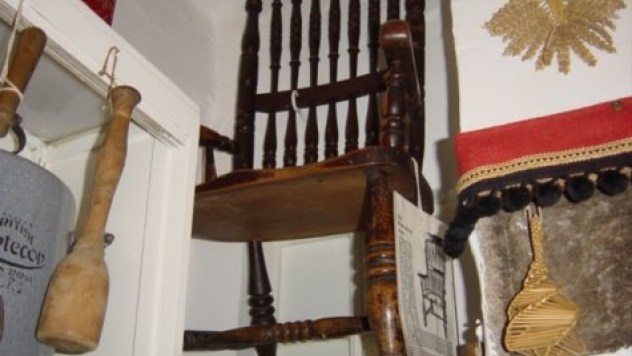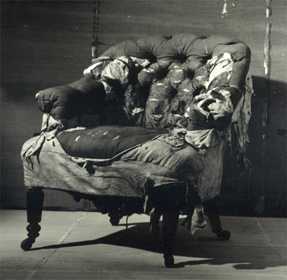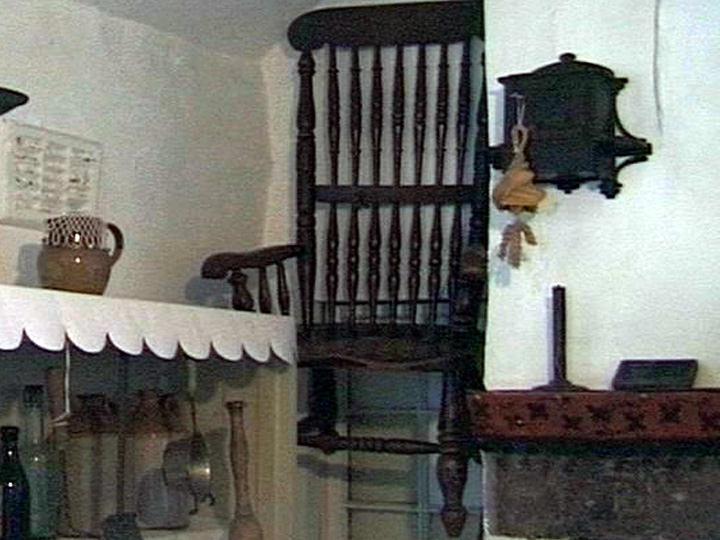
|
|||
Chair of Death - Curse Of The Dead Manís Chair
Source : http://en.wikipedia.org/wiki/Busby%27s_stoop_chair
The Chair of Death was the favorite chair of a striper named Thomas Busby. He was on his way to the gallows in 1669 when he put a curse on it, claiming that anyone who sits in it will soon die. It remained in the pub for centuries, and people were dared to sit in it. During World War II, airmen from an nearby base made the pub a hot spot, and the chair a "hot seat" and people noticed that the ones who sat in it would never come back from war. In 1967, two Royal air force pilots sat in it, and while driving back, they crashed into a tree and died. A few years later, two brick layers decided to try it, and that afternoon, the brick layer that sat in it fell to his death. The cursed chair has apparently "killed" every person who sat in it, no matter what. Some instances include: a roofer who sat in it died after the roof he was working on collapsed, and a cleaning woman stumbled into it while mopping, and was later killed by a brain tumor. Eventually, the pub owner moved it into the basement, hoping that nobody would sit in it. However, one day a delivery man was in the basement and sat in it. An hour later, he crashed his truck and died. After that death, the local museum decided to take it, and to make sure nobody sat in it they hung it five feet from the ground. Recently, the current owner of the pub heard of another death. During World War II, a truck driver picked up two airmen, and they wanted the driver to stop at the pub, and while they were in the bathroom the driver unknowingly sat in the chair. When the airmen didn't return, he left, and when one of them later found him he killed him. It seems, for now, that because it is nearly impossible to be able to sit in it, its "killing" days are over. For over 300 years, mystery and speculation has surrounded the famous Busby Stoop Chair. Thomas Busby was the original owner of what is now known as the Busby Stoop Inn, which is located in Kirby Wiske, a small village near the town of Thirsk, in North Yorkshire. The death of Busby has been popularly associated with a number of fatalities that occurred later in history, mostly because of the chair itself. In the year 1702, Busby had a meeting with his father-in-law, Daniel Auty (some historians use the spelling 'Awety'), with whom he had become a partner in petty crime. After a heated argument, Busby returned to the pub to find Auty sitting in his favorite chair. According to the story, Busby, whose reputation as a drunkard was well known throughout the community, ordered Auty to leave, and after a while, went and found him at what was then called Danotty Hall. Here, police say that Busby murdered Auty with a hammer and hid the body in the woods.
In the late 1800's, a chimney sweep and his friend were sitting in the pub, and the sweep, who apparently had occupied the Busby Stoop Chair, was found dead the next morning, on a gatepost next to the old hangman gibbet. Later, a certain Mr. Earnshaw, who for a time was landlord of the inn, overheard two RAF pilots talking about the famous chair, and witnessed them take turns sitting in it. On that same day, both pilots were killed when their car struck a tree. There are accounts of serveral motorcyclists and bicyclists who, after stopping at the inn for a drink, were later involved in fatal collisions with automobiles.  One man who sat in the Busby Stoop Chair died of a massive heart attack the following night. A hitchhiker, after spending time at the pub for refreshment, and who presumably occupied the famous chair, was struck and killed by an automobile two days later. The inn itself was becoming more and more famous as these stories became widely circulated, and most folks agreed that it was either the most amazing of coincidences, or an example of actual cursed enchantment. The pub was later owned by a brewery, and in the 1970's the landlord asked that the chair be removed from the premises. It is now found in the Thirsk Museum and it is, of course, now protected from occupancy. No one has sat in the famous "haunted" Busby Stoop Chair since 1978. And naturally, the Busby Stoop Inn is a favorite stop for inquisitive ghost hunters and curious tourists. Another Chair Of Death - The Collyer chair Homer Lusk Collyer (November 6, 1881 Ė March 21, 1947) and Langley Collyer (October 3, 1885 Ė March 1947) were two American brothers who became famous because of their snobbish nature, filth in their home, and compulsive hoarding. For decades, neighborhood rumors swirled around the rarely seen, unemployed men and their home at 2078 Fifth Avenue (at the corner of 128th Street), in Manhattan, where they obsessively collected newspapers, books, furniture, musical instruments, and many other items, with booby traps set up in corridors and doorways to protect against intruders. Both were eventually found dead in the Harlem brownstone where they had lived as hermits, surrounded by over 130 tons of waste that they had amassed over several decades. On March 21, 1947, an anonymous tipster phoned the 122nd Police Precinct and insisted there was a dead body in the house. A patrol officer was dispatched, but had a difficult time getting into the house at first, noting however that an awful odor was emanating from somewhere within the building. There was no doorbell or telephone and the doors were locked; and while the basement windows were broken, they were protected by iron grillwork. An emergency squad of seven men eventually had no choice but to begin pulling out all the junk that was blocking their way and throw it out onto the street below. The brownstone's foyer was packed solid by a wall of old newspapers, folding beds and chairs, half a sewing machine, boxes, parts of a wine press, and numerous other pieces of junk. A patrolman, William Barker, finally broke in through a window into a second-story bedroom. Behind this window lay, among other things, more packages and newspaper bundles, empty cardboard boxes lashed together with rope, the frame of a baby carriage, a rake, and old umbrellas tied together. After a two-hour crawl he found Homer Collyer dead, wearing just a tattered blue and white bathrobe. Homer's matted, gray hair reached down to his shoulders, and his head was resting on his knees. Assistant Medical Examiner Dr. Arthur C. Allen confirmed Homer's identity and said that the elder brother had been dead for no more than ten hours; consequently, Homer could not have been the source of the stench wafting from the house. Foul play was ruled out: Homer had died from the combined effects of malnutrition, dehydration, and cardiac arrest. By this time, the mystery had attracted a crowd of about 600 onlookers, curious about the junk and the smell. But Langley was nowhere to be found. In their quest to find Langley, the police began searching the house, an arduous task that required them to remove the large quantity of amassed junk. Most of it was deemed worthless and set out curbside for the sanitation department to haul away; a few items were put into storage. The ongoing search turned up a further assortment of guns and ammunition. There was no sign of Langley. On March 30, false rumors circulated that Langley had been seen aboard a bus heading for Atlantic City. A manhunt along the New Jersey shore turned up nothing. Reports of Langley sightings led police to a total of nine states. The police continued searching the house two days later, removing 3,000 books, several outdated phone books, a horse's jawbone, a Steinway piano, an early X-ray machine, and more bundles of newspapers. More than 19 tons of junk were removed from the ground floor of the three-story brownstone. The police continued to clear away the brothers' stockpile for another week, removing another 84 tons of rubbish from the house. Although a good deal of the junk came from their father's medical practice, a considerable portion was discarded items collected by Langley over the years. On April 8, 1947, workman Artie Matthews found the body of Langley Collyer just 10 feet from where Homer died. His partially decomposed body was being eaten by rats. A suitcase and three huge bundles of newspapers covered his body. Langley had been crawling through their newspaper tunnel to bring food to his paralyzed brother when one of his own booby traps fell down and crushed him. Homer, blind and paralyzed, starved to death several days later. The stench detected on the street had been emanating from Langley, the younger brother. Both brothers were buried with their parents at Cypress Hills Cemetery, Brooklyn.  The chair in which Homer Collyer had died. Upon being removed from public exhibit in 1956, the Collyer chair passed into the hands of private collectors. As time went by, it acquired a reputation of being cursed, due to the misfortunes of its owners. Today, the Collyer Death Chair is maintained in the holdings of a collector of oddities named Babette Bombshell of Orlando, Florida. There was also a great deal of garbage. The house itself, having never been maintained, was decaying: the roof leaked and some walls had caved in, showering bricks and mortar on the rooms below. The house was eventually deemed a fire hazard and was razed. Some of the stranger items were exhibited at Hubert's Dime Museum, where they were featured alongside Human Marvels and sideshow performers. The morbid centerpiece of this display was the chair in which Homer Collyer had died. The Collyer chair passed into the hands of private collectors upon being removed from public exhibit in 1956. As time went by it acquired a reputation of being cursed, due to the misfortunes of its owners. Submit News/Videos/Links | Discuss article | Article Link | More Unsolved and Unexplained Mysteries |
More can be addded on request. Direct your requests at vinit@theunexplainedmysteries.com
